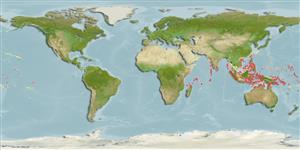Environment: milieu / climate zone / depth range / distribution range
экология
морской; солоноватоводный ассоциированный с рифами; пределы глубины 3 - 20 m (Ref. 41464). Tropical; 30°N - 15°S
Indo-West Pacific: East Africa to Samoa, north to the Ryukyus, south to the southern Great Barrier Reef.
Size / Вес / Возраст
Maturity: Lm ? range ? - ? cm
Max length : 47.0 cm TL самец/пол неопределен; (Ref. 57749)
Краткое описание
морфология | морфометрия
позвонки: 105 - 113. Body depth 36-51 times the total length (TL) . Head length 10-15 times TL. Dorsal and anal fins continuous with caudal, clearly behind the anus. Distances from snout to dorsal origin, from snout to anal origin and from snout to anus are 75%, 69% and 67% of TL, respectively. Small pectoral fins. 63 pores along the lateral line from head to anus. Adults all brown on the back and lighter on the belly; juveniles have an orange-yellow back and a bluish belly. Specimens in the rivers can reach 47 cm TL (Ref. 57749).
Occurs in estuaries and lower parts of the rivers at juvenile and immature adult stages in slow-running waters on sandy bottoms. Mature females stay on shallow marine bottoms; males are pelagic. Reproduction occurs offshore. Leptocephali migrate to the littoral to follow up with their growth. Feeds on fish and invertebrates, especially crustaceans (Ref. 57749).
Life cycle and mating behavior
половая зрелость | размножение | нерест | икра | Fecundity | личинки
Castle, P.H.J., 1986. Moringuidae. p. 187-188. In M.M. Smith and P.C. Heemstra (eds.) Smiths' sea fishes. Springer-Verlag, Berlin. (Ref. 5501)
Статус Красного Списка МСОП (Ref. 130435)
Угроза для людей
Harmless
Использование человеком
дополнительная информация
народные названиясинонимыобмен веществхищникиэкотоксикологияразмножениеполовая зрелостьнерестSpawning aggregationFecundityикраРазвитие икры
Возраст/РазмерыростЗависимость между длиной и массой телаЗависимость между длинамиРазмерный составморфометрияморфологияличинкидинамика численности личинокпополнениечисленностьBRUVS
ссылкиаквакультура (рыбоводство)особенности рыбоводствастепень растяжениягенетикаElectrophoresesнаследуемостьболезниобработкаNutrientsMass conversion
соавторыизображенияStamps, Coins Misc.звукиCiguateraскоростьтип плаванияжаберная областьOtolithsмозгзрение
инструменты
Специальные отчеты
Скачать в формате XML
ресурсы в Интернет
Estimates based on models
Preferred temperature (Ref.
123201): 27.1 - 29.3, mean 28.7 °C (based on 1829 cells).
Phylogenetic diversity index (Ref.
82804): PD
50 = 0.5003 [Uniqueness, from 0.5 = low to 2.0 = high].
Bayesian length-weight: a=0.00102 (0.00046 - 0.00225), b=3.06 (2.88 - 3.24), in cm total length, based on all LWR estimates for this body shape (Ref.
93245).
Trophic level (Ref.
69278): 3.1 ±0.1 se; based on diet studies.
Fishing Vulnerability (Ref.
59153): Moderate vulnerability (37 of 100).
Nutrients (Ref.
124155): Calcium = 46.4 [25.3, 78.7] mg/100g; Iron = 0.519 [0.303, 0.892] mg/100g; Protein = 18.5 [16.3, 21.1] %; Omega3 = 0.105 [0.046, 0.276] g/100g; Selenium = 31.8 [16.5, 63.3] μg/100g; VitaminA = 76.2 [20.3, 251.3] μg/100g; Zinc = 1.63 [1.13, 2.24] mg/100g (wet weight);
